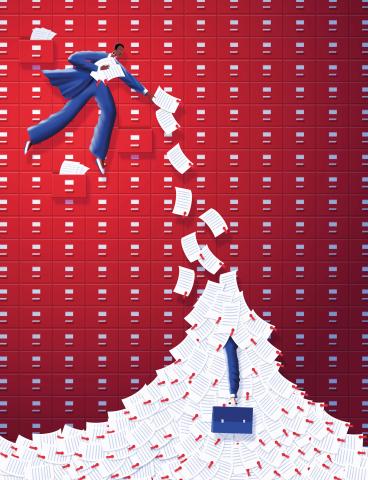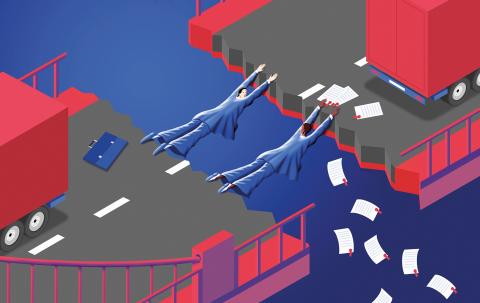Story by Jack Croft
Illustrations by Mirko Cresta
Whether it’s trains, planes and automobiles; telecommunications; banks and the stock market; health care; clean air; education; energy, water and wastewater; beauty parlors and barbershops; or restaurants—it’s hard to think of a business that is not somehow linked to federal, state and/or local government through oversight, regulation, taxation or public-private partnerships.
“In general, I think people have this assumption that government and business are relatively independent,” says Chad Meyerhoefer, who holds the Arthur F. Searing Professorship and is chair of the department of economics at Lehigh Business. “But they’re more intertwined than is widely known.”
Alberto Lamadrid, an associate professor who holds the James T. Kane Faculty Fellowship in the economics department at Lehigh Business, agrees. Lamadrid co-teaches a “Government and Society” course in the MBA program and starts the course by asking students to think of a typical day.
“From the moment you wake up in the morning, until you go to work, there is so much regulation embedded in your life that you don’t realize,” Lamadrid says.
“If you use an alarm clock, it no longer contains noxious metals, as was the case with previous electronics,” he says. “The language you hear on the radio is regulated by the Federal Communications Commission. The nutrition facts label on the coffee you brew and food you eat for breakfast are required by the federal Food and Drug Administration.”
Lamadrid continues, “If you drive to work, the roads and bridges you travel on were funded by governments, as were the traffic lights that keep chaos at bay and govern which vehicles have the right to cross an intersection and when. The car you drive must meet certain federal safety standards. Once you arrive at work, health and safety standards that have been set by the Occupational Safety and Health Administration must be adhered to, so the workplace is safe for employees.”
As ubiquitous as these moments of intertwining government and business appear in the United States, there are often complaints that government regulation stifles innovation.
“In business, everybody has this initial reaction that intervention by the government is bad, because it slows business operations down,” says Steven Savino, a professor of practice in marketing at Lehigh Business. Savino worked in senior leadership positions for multiple, multinational firms during his 25 years as a professional marketer. “There’s some truth to that,” he says.
“But at the same time, business and government are interdependent because businesses need government action for a number of things that complement the organization’s go-to-market plans.”
Infrastructure, for one, Savino says. Also, business needs the government, “to make sure there are fair practices across whatever industry we’re competing in. That way, companies within our industry don’t cheat.”
Government also has the responsibility to set regulations that protect health and safety, he adds.
On the other side, the government needs business, “for job creation and to stimulate economic activity,” says Savino. “The more economic activity you stimulate, you create greater wealth, and the more wealth you create, the more you solidify a viable, robust middle class.”
Here are just a few areas and approaches that help illustrate the countless ways that government and business can forge successful partnerships that are not only mutually beneficial, but also contribute to the greater good of society.
Government Regulation
As a former deputy chief economist at the Securities and Exchange Commission (SEC) and, prior to that, senior economist at the Board of Governors of the Federal Reserve System, Kathleen Hanley has a deep understanding of government regulation.
“I don’t think that every government regulator is an expert in the business that they’re trying to regulate, so
information needs to flow in both directions,” says Hanley, who holds the Bolton-Perella Endowed Chair in finance and serves as director of the college’s Center for Financial Services. “The government should not have unilateral ability to impose potentially costly and burdensome regulations on firms without firms having input into the impact it may have on their businesses.”
That input comes through the legally mandated comment period for all regulations, during which all interested parties can make their views known. “By law, regulators must respond to comments that are material in the final rule. Businesses spend a lot of money for attorneys and lobbyists to write comment letters highlighting things about the regulation they approve of or think are deficient.”
The comment process might continue for months or even years for large rulemakings, Hanley says. “At the end of the day, if firms disagree enough with the provisions of the rule, they may seek relief through the court system.”
Sometimes the SEC wins. Hanley recalls, “I worked on a rule in which my cost benefit analysis bulletproofed the SEC and they won. But, I’ve seen it the other way, too, where rules have been contested in court and the SEC has lost in a big way.”
The complex issues surrounding artificial intelligence illustrate the need for government and technology companies to work together on developing regulations, says Andrew Ward, professor who holds the Charlot and Dennis E. Singleton ’66 Chair and is chair of the management department at Lehigh Business.
“You can’t really expect members of Congress to have this deep understanding of AI and what it can do,” Ward says. “How should they even go about regulating AI?”
Leading companies in the development of AI, including OpenAI, Microsoft and Google, agree that regulation is necessary because of the potential dangers AI poses. AI can be used for harmful and nefarious purposes.
“Regarding AI, there needs to be much more cooperation between government and business to help define that regulation,” Ward says. “Even allowing companies to influence the regulation that could affect their business.
“With self-regulation, companies can help the political arena better understand the issues, challenges and dangers of AI.”
Infrastructure & Supply Chain
When an elevated section of I-95 in Philadelphia collapsed on June 11, 2023, after a fiery crash involving a tractor-trailer hauling gasoline, it temporarily severed a main artery in the nation’s supply chain. Nine million trucks, carrying $195 billion in freight, travel on I-95 (the country’s busiest interstate) each year.
In only 12 days, the interstate was repaired and reopened, thanks to an extraordinary public-private effort that involved federal and state governments, a local private company that developed an innovative foamed glass aggregate used as backfill, other private contractors and skilled union labor.
“Neither the government nor private industry could have done this alone. They had to work together,” says Georgette Chapman Phillips, the Kevin L. and Lisa A. Clayton Dean of College of Business at Lehigh.
It was estimated that the detour around the collapsed section added at least 45 minutes to an hour—and often even longer delays—for trucks hauling goods, reports Zach Zacharia, an associate professor of supply chain management, interim chair of the decision and technology analytics department and director of the Center for Supply Chain Research at Lehigh.
“The more time you take to get somewhere, the more someone’s going to have to pay because there’s more fuel utilized (and wasted) while you’re just sitting there,” Zacharia says. “These additional costs eventually are paid for by the consumer.”
In the Lehigh Business Supply Chain Risk Management Index—a quarterly report compiled by the
Center for Supply Chain Research and the Council of Supply Chain Management Professionals—one of the 10 risk factors measured is “Government Intervention.” Among the main factors supply chain professionals are concerned about, since the index was launched in 2020, are new regulations, tariffs, trade wars, government restrictions on source materials, source technologies, and Russia’s war on Ukraine, among others.
“Actually, government intervention risk over almost three years has been relatively low,” Zacharia says. “That metric has been in the low 70s, while some of our highest risks went all the way up to 90.”
Health Care
If you want to know why government and business are so interdependent in the health care field, follow the money.
“If we examine funding for health care, it has come increasingly from the public sector, but the provision of health care and insurance plans themselves are increasingly from the private sector,” Meyerhoefer says.
“The reason why health care has become so intertwined with the government is just because the funds that pay for health care have shifted more toward public sources.”
Between Medicaid, the Affordable Care Act (ACA) and Medicare, greater numbers of children, adults and older Americans depend on some form of government funding for their health care.
Medicaid expansion programs are covering more poor children than in the past. “Depending on the state, on average, these programs are covering kids up to 300% of the poverty line,” Meyerhoefer says. “That’s quite a few children. In the past, those children were either uninsured or they were insured through their parents—private sector plans that were limited in scope.”
The health exchanges established under the ACA for people who are independently employed, or who can’t get health coverage through their employer, offer a different example of the intertwining of government and business in health care.
“In this instance, a private company provides the insurance plan, but the insurance coverage is managed through a government exchange,” Meyerhoefer says. “The government establishes the health insurance marketplace, regulates the market and manages how those plans are offered to consumers. The private companies actually sell the insurance plans to consumers. It’s a public-private partnership.”
Medicare Part C is known as a Medicare Advantage Plan. The plans are offered by private companies that have been approved by Medicare and, according to the U.S. Department of Health and Human Services
(HHS), “may offer extra coverage, such as vision, hearing, dental, and/or health and wellness programs. Most include Medicare prescription drug coverage (Part D). So, Medicare Part C and D involve buying plans from private companies.”
Meyerhoefer further explains, “One of the main advantages of having private insurance companies design and administer multiple plans is choice. Instead of there being one government plan, where everybody is under the same plan, with the same amount of coverage for the same drugs at the same level, private insurance companies can offer multiple plans to consumers, by segmenting the market and giving different sectors of consumers plans that are more attractive to them.”
However, older Americans, “have a hard time comparing the plans and digesting all the information,” Meyerhoefer explains. “Sometimes, choice can be bad if you need a consultant to explain all these different options to you. So that choice does have a cost, but theoretically, choice is the benefit.”
Meyerhoefer says the bottom line is, “everything is connected in health care; it’s not an unfettered private market. The government’s actions have a ripple effect in the private insurance market and vice versa.”
Energy
Throughout the Great Depression and leading into World War II, building electricity generation plants to power U.S. growth and production on a large scale was primarily the province of the federal government. During this period of American industry, two marvels, the Hoover Dam and the Grand Coulee Dam, were built.
“Nowadays, a lot of our country’s infrastructure is actually managed by businesses,” Lamadrid says, “not by the government, like it was initially. Over the last 60 years, we’ve seen a lot of restructuring, so generation plants, for example, are now managed by private entities. However, the government still plays a role in regulating them.”
Just as the government invested huge sums in hydroelectricity in the 1930s, it continues to be a key early investor in alternative energy sources, Lamadrid says. “In certain cases, past subsidies can actually bear fruit much later in the process,” he says.
Lamadrid cites two examples. The first involves the U.S. Department of Energy’s investment in efforts to figure out how to extract natural gas from shale rock formations starting in 1978. “For a long time, we knew that there was gas in the shale formations,” he says, “but we didn’t know how to start extracting it in an economical manner. For around 15 years, the federal government was subsidizing the investigation into natural gas extraction.”
By the early 1990s, Lamadrid says, the government abandoned these efforts. Private entrepreneurs, however, stepped in and eventually found economical ways to extract natural gas.
“Eventually, the effect the shale gas revolution had in decarbonizing the electricity system, can’t be overstated,” he said. “Right now, natural gas produces approximately one quarter of the emissions as coal. Because of that shift, we have made our electricity system much cleaner.”
The same thing is happening with renewable energy, Lamadrid says. “There have been a number of subsidies for many years now that help to develop technologies—wind turbine technology, photovoltaic technology. During the last decade, we have seen the cost of solar panels dramatically reduced, almost 20-fold in certain cases. Because of that, companies are going solar, not because they have the subsidies, but because it’s the cheapest thing to do.”
Capstone
Steven Savino teaches a capstone course in the masters in management program that involves students working on projects with leading iconic companies. One of those companies is Pratt & Whitney, an aerospace manufacturer with extensive government defense contracts that make up their global operations.
“There are plenty of examples of the amount of time, money and effort toward innovations that benefit the government—with Pratt & Whitney our Army, Navy and Air Force. These technological innovations, in this case with state-of-the-art jet engines, often translate to the consumer sector,” Savino says.
“The partnership between government and industry eventually finds its way, whatever the innovation is, into consumer markets, benefiting everyday consumers with breakthrough new products.”
Your Fair Share of Taxes?
Bob Duquette, a teaching full professor in accounting at Lehigh Business, who previously worked as a director of mergers and acquisitions, understands why most people will never agree on what their “fair share of taxes” is.
“Either with respect to what you as an individual pay the federal government or what a business pays the federal government or what you or a business pays the state or local government, there is some overlap in tax paying, but there are also different levels of service for individuals and businesses. The laws and rates
frequently change.
“You have this confusing world where the government requests you pay what they call your fair share of taxes that you owe. And there’s little explanation as to how the government came up with the “fair share” amounts.
Duquette adds that few taxpayers understand what their tax dollars are actually paying for.
Public schools, public safety (police, fire, emergency services), public health (protecting and improving the health of people and their communities) and health care (Medicare and Medicaid), infrastructure, public transportation, national defense, air safety, disaster relief—the list goes on and on.
“I don’t think most Americans fully understand or appreciate all of the services we have come to expect,”
he says.




